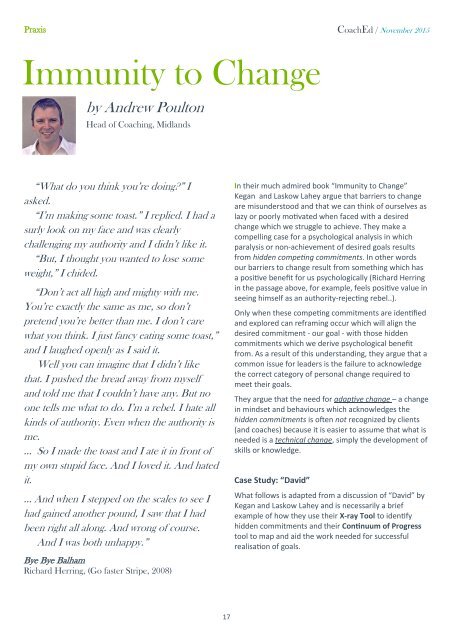The Teaching Leaders Coaching Journal
21dX4iN
21dX4iN
Create successful ePaper yourself
Turn your PDF publications into a flip-book with our unique Google optimized e-Paper software.
Praxis<br />
CoachEd / November 2015<br />
Immunity to Change<br />
by Andrew Poulton<br />
Head of <strong>Coaching</strong>, Midlands<br />
“What do you think you’re doing?” I<br />
asked.<br />
“I’m making some toast.” I replied. I had a<br />
surly look on my face and was clearly<br />
challenging my authority and I didn’t like it.<br />
“But, I thought you wanted to lose some<br />
weight,” I chided.<br />
“Don’t act all high and mighty with me.<br />
You’re exactly the same as me, so don’t<br />
pretend you’re better than me. I don’t care<br />
what you think. I just fancy eating some toast,”<br />
and I laughed openly as I said it.<br />
Well you can imagine that I didn’t like<br />
that. I pushed the bread away from myself<br />
and told me that I couldn’t have any. But no<br />
one tells me what to do. I’m a rebel. I hate all<br />
kinds of authority. Even when the authority is<br />
me.<br />
… So I made the toast and I ate it in front of<br />
my own stupid face. And I loved it. And hated<br />
it.<br />
… And when I stepped on the scales to see I<br />
had gained another pound, I saw that I had<br />
been right all along. And wrong of course.<br />
And I was both unhappy.”<br />
Bye Bye Balham<br />
Richard Herring, (Go faster Stripe, 2008)<br />
In their much admired book “Immunity to Change”<br />
Kegan and Laskow Lahey argue that barriers to change<br />
are misunderstood and that we can think of ourselves as<br />
lazy or poorly motivated when faced with a desired<br />
change which we struggle to achieve. <strong>The</strong>y make a<br />
compelling case for a psychological analysis in which<br />
paralysis or non-achievement of desired goals results<br />
from hidden competing commitments. In other words<br />
our barriers to change result from something which has<br />
a positive benefit for us psychologically (Richard Herring<br />
in the passage above, for example, feels positive value in<br />
seeing himself as an authority-rejecting rebel..).<br />
Only when these competing commitments are identified<br />
and explored can reframing occur which will align the<br />
desired commitment - our goal - with those hidden<br />
commitments which we derive psychological benefit<br />
from. As a result of this understanding, they argue that a<br />
common issue for leaders is the failure to acknowledge<br />
the correct category of personal change required to<br />
meet their goals.<br />
<strong>The</strong>y argue that the need for adaptive change – a change<br />
in mindset and behaviours which acknowledges the<br />
hidden commitments is often not recognized by clients<br />
(and coaches) because it is easier to assume that what is<br />
needed is a technical change, simply the development of<br />
skills or knowledge.<br />
Case Study: “David”<br />
What follows is adapted from a discussion of “David” by<br />
Kegan and Laskow Lahey and is necessarily a brief<br />
example of how they use their X-ray Tool to identify<br />
hidden commitments and their Continuum of Progress<br />
tool to map and aid the work needed for successful<br />
realisation of goals.<br />
17


